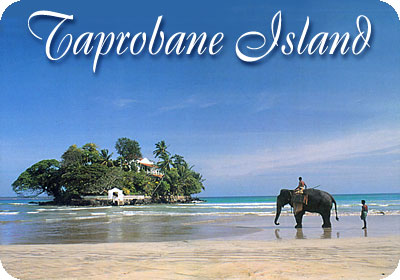
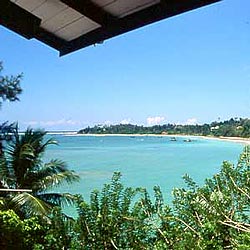
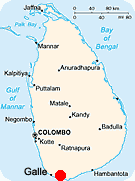
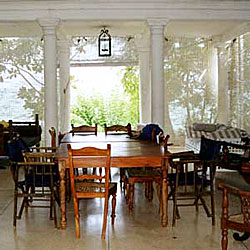
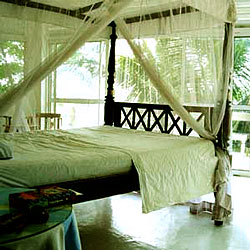
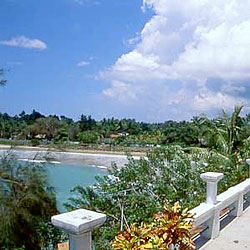
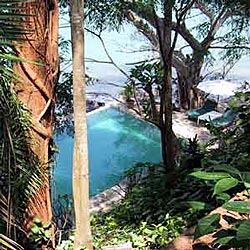
Count Maurice Maria de Mauny Talvande of France
A brief synopsis of his life and times
Beginnings
Count de Mauny of Talvande, whose actual name was Maurice Maria Talvande, was born on March 21 1866 in Le Mans. His father was Felix Talvande He adopted the prefix of "Count de Mauny" from his mother, Mme Margeruite de Mauny Talvande, and the suffix of "Talvande" from his father, Felix Talvande, who was a bank manager in provincial France. His father died in 1901, in or near Nantes and his mother died in 1907 in Pontvallain. His mother, whose full name was, Margeurite Adelaide Louise Froger de Mauny was born in 1842. Her parents were Alexandre Jacques Eduard Froger de Mauny and Henriette Martin Lavallee. His father, Felix Talvande was born in 1832 and his parents married in Le mans on June 8 1862. Maurice was born four years later in Le Mans where his father was then employed as a bank manager of the Le Mans branch of Banque de France until 1866. After 1868 Felix worked as a banker at Portet-Lavigierie et Talvande which became the Bank Talvande in 1882 until it and Talvande himself were made bankrupt in 1889. The bankruptcy was announced on March 17 1889 where his company, Talvande & Company, and himself were both declared insolvent. Marguerite applied for legal separation from Felix in 1890 and thereafter resided with her mother at Domaine du Bourg in Pontvallain, which had been in the possession and ownership of the de Mauny family since 1859.
On the death of his mother, Maurice inherited Domaine du Bourg, the family home, which he then sold and shared the proceeds of 17000 francs with his brother Roger and sister Suzanne-Marie. Roger had a son named Albert Talvande.
Education
Maurice attended St Mary's College at Hales Place in Canterbury, which was run by French Jesuit Priests, during the period 1883-1884. His brother Roger also attended St Mary's College and stayed on for a longer period from 1883-1888. Maurice, subsequently, went to Saint-Cyr Military College which was also influenced by the Jesuit Order. Despite the basic French environment that he was surrounded by, Maurice probably learned his English too while he was under their tutorship.
His close friendship with George Byng, brother of Lady Mary, whom he first met at St mary's College in Canterbury, may have given him the opportunity to meet Mary, in the first place, and then develop into a relationship that ended in marriage to her. After completing his education, it is reported that, he travelled widely in America for several years. He is reported to have sailed from Le Havre and arrived in New York, in the US, on Nov 19 1894 on board the 9,000 ton SS La Touraine., being in transit to Boston, in a journey that lasted about seven days.
Marriage & Children
Count Maurice Maria de Mauny Talvande married Lady Mary Elizabeth Agnes Bynge, daughter of the fourth Earl of Strafford, enry William John Byng, on June 24, 1898. The wedding was a great social occasion and attended by the Princess of Wales, Princess Christian and Prince and Princess Saxe-Weimer. His mother Mme de Mauny Talvande and brother Roger de Mauny Talvande also attended. His father, Felix Talvande, was not present. The bridegroom was 32 and the bride was 33 years old at the timeof their marriage. The newly wed De Mauny's settled down in 1898 at the famous Azay-le-Rideau castle, whose long and memorable history goes bact to the reign of Francois I in the sixteenth century. From Azay, Maurice and Mary moved to cannes where their son Victor Alexander Christian henry George was born on April 19 1899. From here they moved briefly to San Remo and then returned to England.
On their return from France in 1900 the de Mauny family moved to an old Queen Anne house called "Terrick House", near Ellesbrough in Buckimhamshire. A daughter, Alexandra Mary, was born here on July 19 1904.
Sir Henry Byng, Fourth Earl of Strafford
Mary's father, Sir Henry Byng, succeeded his brother as the Fourth Earl of Strafford in march 1898, a few months before her wedding to Maurice. Sir Henry married bis second wife, Cora, a widow from America, in December of the same year. His first wife the Countess Henrietta Danneskiold Samsoe, Mary's mother, died in 1880 when Mary was only 15 years old. Sir Henry was killed in a train accident by the Great Northern express at Potter's Bar station in North London. His death was something of a mystery that has not been unravelled. The coroners inquest revealed that Lord Strafford arrived from London by train and took a taxi to his country seat at Wrotham Park in Barnet. At some point along the way to his home, he had stopped the taxi and alighted from it. A telegraphist in the Potters bar Signal Box had then seen him stepping over the signal wires in front of the approaching train. His decapitated body was found on the track soon after the incident. Medical evidence presented at the inquest revealed that the Earl had a history of mild seizures after which his mind and body was temporarily dazed and semiconscious. No evidence of a possible suicide was presented. The verdict was that death was caused by misadventure.
Sir Henry Byng had two sons by his first marriage, both of whom were unmarried and died at an early age. His first son, George, born on April 1 1867, Page of Honor to Queen Victoria, ADC to the Governor of cape of Good Hope, died by drowning on route from Naples to Gibraltar on April 4 1893. The second son, John, born on March 8 1870, was an attache in the diplomatic services in Paris and died on Januray 6 1894 at rue Chaillot in Paris. It is believed that it was probably George who initially introduced Mary to de Mauny. Sir Henry was succeeded by his brother Francis Edmund, a chaplain in ordinary to Queen Victoria as well as the vicar of St Peter's in Kensignton.
His Books
Maurice is reported to have written three books, during hislifetime, titled as follows:-
1. "The Peace of Suffering 1914-1918", published in England by Grant and Richards of St Martins Lane in London in 1919. The book is supposed to reveal extensive evidence for his state of mind just after WW I. It also provides a specific timetable for his whereabouts during this period as the chapters are dated and geographically documented.
2. "Gardening in Ceylon", a book which reveals the Counts abilities not only in the field of gardening but also his talent as a distinctive writer in English since he was a native French speaker after all.
3. "The Gardens of Taprobane", published by Williams and Norgate of Great Russel Street, London in 1937, and edited by Bernard Miall. The book is an important classic on gardening in Ceylon and also serves to illusrtate a great deal of facts about De Mauny himself. This very rare 320 page edition is written in the form of a diary which covers almost six months of its authors life in Ceylon.
The books that he wrote give a great deal of information of his life and its chronology with many facts that can be extracted related to places, events, dates and times. The Gardens of Taprobane, on page 266, relates,
"I vividly remember the first time I saw Gloriosa Superba in flower. It was in the greenhouse of a friend of mine at Parkstone, near Bournemouth ... I asked my friend where it came from. He told me that he had dug up the rhizome himself in the jungle in Ceylon.... This is why I came here the following winter (1912); and once here, I made Ceylon my second home; the home I had dreamt of. The second time I came across Gloriosa Superba was in December 1912. I had just landed in Ceylon and was motoring up-country."
In his book, Gardening in Ceylon, which was published by H W Cave & Company in Colombo in 1921, he made great attempts to describe the making of a garden, its formation, climate, altitude of the ground, the soil and other relevant details of foliage. The successive chapters of the book provide descriptions and illustrations of gardens, including those of the Roehampton Estate, the Netherleigh Estate, the Leefe Garden in Colombo, the Haggala Botanic Gardens, and the Peradeniya Botanical Gardens.
Life in Ceylon
Maurice was a great traveller. It is believed that he visited Ceylon for extended periods of a time a year or two after 1910. William Warren has suggested in "Tropical Asian Style", that de Mauny was first invited to Ceylon in 1912 by Sir Thomas Lipton, the tea magnate. Warren has conjectured that it was some 'great personal disaster' that drove de Mauny to Ceylon. It is possible that both his diminishing financial status and also his many marital problems he was facing may have been the reasons for his move eastwards.de Mauny travelled several times between Hampshire and Ceylon soon after his bankruptcy problems. His skills as an expert gardener and furniture maker in Ceylon, and, later on Journalism, may have provided him with the necessary finances to supplekent his travel and living. There are accounts from people who knew him in Ceylon that he also used to receive remittances from overseas which probably could have beensent by his wife, Mary, from time to time for his upkeep and living. It is reported that he also ran a furniture factory and workshop in Colombo. A number of de Mauny furniture pieces have survived in the hands of private owners. They are now highly valued and cherished in Sri Lanka. He started the "Weligama Local Industrues" in 1925 which as he claimed gave employment to over 200 carpenters, carvers and inlayers. By 1930, the enterprise suffered at the hands of the Depression and had to be halted until better times. It was restarted in 1936. The craftsmanship was most admirable and the designs were very much French styles of that time.
Ferguson's Ceylon Directory for 1920-21 shows that his address was 'Ascot', Albert Crescent, Cinnamon Gardens, Colombo 7, a very elite and high-society area of Colombo. His son, Victor, is also listed as living there. It was in September 1927 that he saw for the first time, and quite by chance, a place that was to become his final home. At the center of the arc of the Bay of Weligama, in the southern tip of Ceylon, 'a red granite rock, covered with palms and jungle shrub, rising from the Indian Ocean - an emerald in a setting of pink corral' was where he finally chose to build andlive his eternal dream of peace and tranquility close to nature that he loved so much. He swam across the narrow straight and saw an admirable view as he reached the plateau of the rock. "There was nothing", he recalled some ten years later, "between me and the South Pole".
Having located and identified his magical island, which was only a few acres in area, de Mauny then set upon the task of building it into his future home that he had been dreaming of for so many years. The foundation stone of the house was laid on February 1 1927 and thus initiated the beginning of what was to become a famous and much visited site by many distinguished persons. The seeds of "The Gardens of Taprobane" had been planted. The island was named "Taprobane" based on the ancient name for Ceylon given by the Greeks and also because it suited its pear-shape outline more like a mini Ceylon itself. The local name, by tradition, for the sland was "Galduwa" meaning "Rock Islan" in Sinalese. It is conjectured that the island may have been a art of the mainland in ancient tmes as it is not shown in maps of the Portuguese Colonial era. The name Taprobane is also considered to have been originated from the sanskrit "Tamba Vanna" meaning "copper colored" as a reference to the many famous golden beaches of Ceylon.
The house was built on a 135 feet square area with a broad terrace surrounding it. It was octagonal in shape spanninga surface of 25 by 25 yards. This gave the resident and eight faced view of the outsde world with the north side facing towards the mainland and the south facing Antarctica in the South Pole. The central hall was called the "Hall of Lotus" and was also octagonal in shape measuring 26 by 26 feet. A 30 foot high dome lined with eight panels of inlaid wood was located in the center of he hall. The panels were dyed with an opaque gold and blue color and bore designs of Lotus buds and flowers. The dome was supported by eight square pilars of Wedgewood-blue, 24 feet tall. On either side of these were two light columns, 12 feet tall, making sixteen in all, terracotta with gilded capitals. They supported a white stone traverse that connected the pillars in an arch that was 12 foot span. This was hung with curtains of soft blue silk with a deep brocaded border of art noveau design at the bottom colored black and gold on cream. The rooms converged on the hall through eight arches. A Sigiriya frescoe styled border ran along the stone white walls. The whole scheme was engulfed in a golden hue by light entering through Venetian blinds created out of amber colored glass. The furniture within was made by local craftsmen using some of the rarest woods of Ceylon. They were mainly of French style although here were any pieces that belonged to the Dutch designs too. A carpet of Maidenhair ferns and a light bronze creeper with clumps of Eucharist Lilies adorned the hall. From the north-east terrace here was a splendid view of the shoreline, the forest of coconut palms fringing the Bay of Weligama, and the copper colored sands clustered with boats on a pea-green sea. Through the entrances of iron gates, with their design of brass-headed peacocks with prussian blue eyes one could see he openness and vastness of the mighty Indian Ocean sprawling through time.
The Count was residing at Weligama 1931. His son, Victor Alexander, was then residing at "Boxmead", Turret Road (now renamed to Dharmapala Mawatha and running from Kollupitiya junction in Colombo 3 all the way down to Liptons Circus in Colombo 7, bounding one of the most prestigious residential areas of Colombo), Colombo 7. Victor was employed at the Rosehough Tea Company, first as an Assistant and then as an under-manager. It is also reported in the Fergusons Directory that he held the position of Second Lieutenant in the Royal Navy. he went on to become a Commander in the Royal Navy in WW II, wher he was awarded the DFC. He eventually went on to become the Chairman of Rosehough until he resigned in the early 1970's.
Local records in Sri Lanka show that the island was actually purchased by de Mauny for a sum of Rs 250 in 1925 in the name of his son Victor Alexander. It remained in his ownership until it was sold by public auction, in 1942, for Rs 12,000.
The Count encouraged people to visit is island. His historical visitors book was filled with names of Kings, Princes, Dukes, Duchesses, Aristocrats, Prime Ministers, and other famous personalities from across the blue marble.
Count Maurice de Mauny Talvande died on November 27 1941 while at the Chelvarayan Estate, Navatkuli, in the northern city of Jaffna in Ceylon. Hs remains were buried at St Mary's Burial Grounds in Jaffna. John Lambert, a soliciter at the Chelvarayan Estate, is registered as the person who buried the body. Cause of death was given as "Angina Pectoris" which in common terms spells out as a "heart attack". The Ceylon Daily News, in its edition of Friday November 28 1941, had this printed in its obituary column:-
"The death has occurred in Jaffna yesterday of the Count de Mauny, who had resided in Ceylon for over twenty years, making his island home, Taprobane, off Weligama, one of the most attractive show pieces of the kind. A French Catholic, the count became a naturalized Englishman.
He was married to a daughter of the 4th Earl of Strafford and had one son, Mr V A de Mauny, wo served with the British Navy in the last Great War and rejoined when the present hostilities broke out.
The late Count de Mauny's principal hobbies, in which he was himself an adept, were the laying out of beautiful gardens and furniture craftmanship, whch he turned into an art. Besides his own at taprobane, many of Colombo's most pleasing gardens owe their inspiration to him.. His book The Gardens of Taprobane published in London some years ago, met with a good reception.
Count de Mauny who was nominated to he Weligama Urban Council, took a keen interest in public afairs and there was a time when he was a prolific writer to the newspapers. At ne period he was even a member f the Laboru Union.
The funeral akes place this morning."
A copy of the death certificate of Maurice, found among his daughters papers, is dated May 16 1947 which was a year after her mothers death. It was issud to the firm of soliciters Of F J & G de Saram of Colombo who were probably the executors of the estate of both her parents.
Maurice's son Victor passed away in 1978 and his daughter Alexandra died in 1989. They were both chidlless.
de Mauny's island was a very famous destination for many notables from different nations. The island was sold by public auction in 1942 after having been neglected ad in a state of derelict for many years. In 1951 the island was purchased, from its owner called Mr Jinadasa, for English Pounds 5,000 by the famous American writer Paul Bowles whose first visit to Ceylon was in 1949. Bowles sold the island n 1956 to the Irish writer Shaun Mandy. For several years, since 1964, the island was in the ownership of of the de Silva whose senior member was Desmond de Silva QC, the very distinguished British barristor. The island was then on a long lease to to the very successful HongKong business tycoon Geofrey Dobbs. It may be interesting to note that the wife of Desmond de Silva is Princess Katharina of Yugoslavia.
Pictures taken from the Internet where the famous de Mauny Island has now been refurbished splendidly and is being marketed commercially as a resort island available for renting and occupation by tourists and others for rest and recreation. The current rates being levied, in the year 2003, are between Pounds Sterling 300 and 600 per day for the whole island and villa
 |
 |
|
|
|
|
|
|
|
|
|
Other relevant and interesting information, e-mail, articles, and stories related and exchanged, by genealogy researchers and members of the genealogy forum, about the Count Maurice Maria de Mauny Talvande of France are given below as a matter of interest to those researching his life, history, and adventures related to Ceylon (Sri Lanka).
c.c.
alan-little@virgin.net;
wilkens@bigpond.com.au;
e.edit@btinternet.com;
gengroup
I
am very interested in finding out more about the Count de Mauny Talvande who
bought an island off Weligama. When going home on school holidays from Colombo
to Baddegama near Galle my mother used to point it out to us and say it was
Count de Mauny’s island. I have found the following information from Internet
but don’t seem able to find out the Count’s Christian name and surname.
The
count of Mauny-Talvande, was an exiled French aristocrat. He discovered the
island of Gaduwa off Weligama in 1912 and built a mansion there where, in 1937,
he wrote "The Gardens of Taprobane"
Mauny and Talvande are surnames as well as being a title of the French nobility. The title seems to have passed between the families of Poulain and de Ris. I would appreciate any information. Regards,
Wendy
Garcia (nee Winter).
Information
extracted from the Internet:
Re:
Count de Mauny-Talvande [Sri
Lanka Genealogy Forum].
Posted
by: Yasmin Rajapakse
Date:
March 27, 2001 at 17:10:10
In
Reply to: Re: Count de Mauny-Talvande by Cindy Wilkinson of 854
Dear
Cindy, I was overjoyed to find this site with all the correspondence concerning
Count de Mauny-Talvande. I am researching into his origins. Do let me know your
interest in this subject and if you know more about the Count.I might be able to
give you some interesting information. Looking forward to hearing from you soon,
Regards, Yasmin.
http://genforum.genealogy.com/srilanka/messages/453.html
Re:
Count de Mauny-Talvande
Posted
by: Cindy Wilkinson
Date:
August 08, 1998 at 01:41:08
In
Reply to: Re: Count de Mauny-Talvande by Alan Little of 854
Dear
Alan, Thank you very much for your response vis Count de Mauny. I have found a
copy of the book "The Gardens of Taprobane" in the Oxford
University library (not of great use here in Australia!), but have so far been
unable to locate a copy at any of the bookshops specializing in this type of
material.. Where did you obtain your copy? Or was it luck? Any advice you can
give would be greatly appreciated. The writer William Warren obviously also has
a copy of the book as he used the painting of the Count which you mention to
illustrate a recent article on tropical gardens. Is there much reference in the
book to the Count's friendship with Sir Thomas Lipton? I am aware that he stayed
with him in 1912 but am not sure whether there were other times. You may be
interested to know that the Taprobane house is now for rent as a villa through
an international travel agency which advertises on the net - sounds wonderful as
long as the bats Paul Bowles found there have gone! Cindy Wilkinson
Re:
Count de Mauny-Talvande
Posted
by: Alan Little
Date:
July 20, 1998 at 15:14:51
In
Reply to: Count de Mauny-Talvande by Cindy Wilkinson of 854
Dear
Cindy, There is indeed a lovely book written by the Count de Mauny "The
Gardens of Taprobane" Edited by Bernard Miall, published in London in
1937 by Williams & Norgate. It is all about his island home called Taprobane
just of the coast of Ceylon, and includes several black & white photos of
the house & gardens. The frontispiece is a colour print of the Author from a
painting by David Paynter. I have a copy of the book in my extensive library of
Ceylonese books. There are many lovely references to The Count and his guests. I
imagine it will not be very easy to find a copy as this is long since out of
print, but you may be lucky if you contact a Public Library or a Book Search
Agency. When I visited Sri Lanka in 1995 I passed by 'Taprobane' but
unfortunately did not have time to explore, but it looked rather run down like
so many other places on the island. If I find any other references I will let
you know. Alan
Count
de Mauny-Talvande
Posted
by: Cindy Wilkinson
Date:
July 19, 1998 at 03:54:43 of 854
I
am most interested in finding out further details about Count de Mauny-Talvande
who built his house on the rocky island at Weligama Beach, South West Sri Lanka.
I believe he was an author and furniture maker. Can anyone provide me with more
information, especially if there is anything, which he wrote that has been
published. Are there references to him in any of the historical writings? Cindy
Wilkinson
http://genforum.genealogy.com/srilanka/messages/453.html
Ancestry
Message Boards - Message [French
Nobility]
de
Mauny
Author:
Chomet
Date:
26 Aug 2002 9:11 AM GMT
Surnames:
de Mauny, Talvande
REPEAT
MESSAGE:
Does
anyone know anything about Maurice de Mauny Talvande who was born in 1866 in Le
Mans. S. Chomet
French-nobility-l:
[French-nobility] Froger de Mauny
From:
"e.edit" e.edit@btinternet.com
Subject:
[French-nobility] Froger de Mauny
Date:
Mon, 08 Apr 2002 10:57:03 +0100
I
would be most grateful for ANY information about the Froger de Mauny family, the
last member of which that I know about was resident in the 1880s in Le Mans.
All
replies will be acknowledged with thanks.
Seweryn
Chomet Finst P, Visiting Research Fellow, King's College, London WC2R 2LS
phone:
(0)7092 060530 or (0)207 352 5388
http://home.infospace.com/sewerus1
[French-nobility]
Froger de Mauny by "e.edit" e.edit@btinternet.com
[French-nobility]
Froger de Mauny by Almanach de Bruxelles
AlmanachdeBruxelles@compuserve.com
Re:
[French-nobility] Froger de Mauny by "e.edit"
e.edit@btinternet.com
[WGW, worldgenweb.org].
Date:
Sat, 13 Apr 2002 11:33:46 -0400
The
Encyclopédie de la Fausse Noblesse et de la Noblesse d'Apparence, by P. M.
Dioudonnat, Sedopols 1982 has an entry for family FROGER de MAUNY: Famille
bourgeoise (Chaix). The 1993 Bottin Mondain has one Mme FROGER de MAUNY in
Paris. Regards, Adelin Remy
Dear
Adelin Remy, I am most grateful for your suggestion. The publication of my book
"Count de Mauny - Friend of Royalty" is held up on this particular
point. I will report back as soon as I have seen this publication. With many
thanks, Seweryn
Seweryn
Chomet FinstP, Visiting Research Fellow, King's College, London WC2R 2LS
phone:
(0)7092 060530 or (0)207 352 5388
http://home.infospace.com/sewerus1
Index
des noms commençant par M
MAUNY,
Elisabeth (°avant 1764-†1801 ) × 1779 LELIEVRE
Jean
Claude MAUNY, Jean (°avant 1767-) × 1785 LELIEVRE, Anne
Index
des noms commençant par T
TALVANDE,
Marguerite× DEMOULE, Paul
Issue
Number 4 Napoleonic Literature, Number 4: November 2000
October,
November, December 1800
Chronological
table of the main events during the fourth quarter of 1800 (Year IX)
Freemasonry
under the Consulat and the Empire - Alain Pigeard
The
spread of freemasonry in all ranks of the French army, and in society's upper
classes, dated back to the last years of the Ancien Régime. Freemasony was
going to become highly fashionable and deeply rooted in the armies of the First
Empire; many officers, dignitaries, marshals and generals were freemasons.
A
Murky Affair - Jean Tranié
If
Clément de Ris, Count de Mauny (1750-1827), a lawyer, freemason, friend
of Sieyès, senator, revolutionary, Bonapartist and royalist, has gone down in
posterity, he owed it to "the affair." [La
revue Napoléon pages created by John Schneider, www.napleonic-literature.com].
Armory
of the French hereditary Peerage (1814-30)
The
family name is followed by the dates of the royal ordonnance of appointment, the
title (B=baron, V= vicomte, C= comte, M= marquis, D= duc, P= prince) and the
date of the relevant letters patent. The name of the grantee is on the next
line, and then the coat of arms. For ducal families, there is either or a
listing of the succession of title bearers, or a link to the entry in the Old
Regime peerage page where the listing of all title bearers can be found. A star
before the name indicates that the title survives. Otherwise the date of
extinction is given (e.g., "Ext. 1915").
Dominique
Clément de Ris, comte de Mony (1750-1827)
d’azur
au chevron d’argent accompagné en chef de deuxé toiles d’argent et
enpointe d’une colombe d’argent portanten son bec un rameau d’olivier de
sinople.
Re:
kidnapping of the French senator Clément de Ris during the Napeoleonic wars
/Battle of Mafrengo):
OUVERTURE
DU COLLOQUE - par Jean Tulard [colloque
sur la 2e campagne d'Italie -Marengo]
Balzac
achève en janvier 1841 "Une ténébreuse affaireW". Il s'inspire d'un
fait divers authentique l'enlèvement en plein jour dans son chateau de
Touraine, le 23 septembre 1800, du sénateur Clément de Ris par six
cavaliers vêtus en dragon. Le sénateur fut libéré dans des conditions étranges
par ses propres ravisseurs. Balzac donne de l'événement une explication
curieuse l'issue de la bataille de Marengo ayant été longtemps incertaine et
la nouvelle d'une défaite de Bonaparte annoncée a Paris, Talleyrand, Fouché
et Clément de Ris auraient créé une sorte de triumvirat pour gouverner
la France. Mais quand arriva, peu après l'annonce officielle de la victoire,
Talleyrand et Fouché brùlérent leurs papiers, précaution que Clément de
Ris - bêtise ou projet d'un futur chantage? - n'adopta pas. Fouché
l'aurait fait enlever par d'anciens officiers chouans à son service afin de récupérer
les documents. Rien que l'hypothèse d'un triumvirat Talleyrand-Fouché-Clément
de Ris paraît déja peu vraisemblable.
Martinique
Rhum La Mauny Trois Rivières Duquesne - The History of the La Mauny Plantation
Estate [RhumdeMartinique.com:
Savour of Martinique Rums].
Installed
in Rivière Pilote as of 1749, the La Mauny distillery bears the name of Count
Ferdinand Poulain, Count de Mauny who disembarks in Martinique in the
beginning of the 18th century. A former sugar plantation, La Mauny
was capable of resisting the fluctuations and drop in sugar prices by orienting
itself toward Agricultural Rum production. Resold later to the Codé, and later
to the Lapiquionne families, the estate was purchased by the Théodore and
Georges Bellonnie brothers. As of the outset of the 70s, Mr. Théodore Bellonnie
wished to associated the Bourdillon families to the development of the Rhums La
Mauny company, and the firm took on the name of Bellonnie Bourdillon et
Successeurs.
La
Boutique du Rhum - La Mauny
Le
nom de La Mauny a pour origine celui d’un Comte, originaire de Normandie,
Joseph Ferdinand Poulain, Comte de Mauny qui, débarqué en Martinique en
1749, donna son nom à la propriété. L’habitation La Mauny fut très
longtemps une sucrerie, où l’on fabriquait également un peu de tafia (ancêtre
du rhum de sucrerie).
Informations
généalogiques
POULAIN,
Guillaume
POULAIN,
Guillaume
POULAIN,
Nicolas
POULAIN,
Guillaume
LAISNE,
Perrine
POULAIN,
Bernard Famille
POULAIN - BESSIRARD Mariage: 16 janvier 1720 à 61, La Sauvagère BESSIRARD,
Marie
POULAIN,
Marie Famille
POULAIN - X
POULAIN,
Marie
POULAIN,
Charles Frédéric
POULAIN,
Isidore Frédéric
PERIER,
Anne Louise Françoise
POULAIN,
Charles Frédéric Famille
POULAIN - LE PONTOIS Mariage: 21 octobre 1861, 56, Lorient
LE
PONTOIS, Marie Adeline Emilie
POULAIN,
Frédéric Isidore Eugène
POULAIN,
Charles Léon Naissance : 07 mars 1864 à 56, Lorient Décès : 13 avril
1892 à 35, Montfort sur Mer
POULAIN,
Marie Eugénie Magdeleine
POULAIN,
Eugène Naissance: 1870
POULAIN,
Madeleine Adèle Marie Naissance : 15 juillet 1879, 56, Port Louis, place
du Marché, Décès : 18 septembre 1882 à 56, Port Louis, place du Marché Famille
POULAIN - X
POULAIN,
Frédéric Isidore Eugène
POULAIN,
Charles Léon Naissance : 07 mars 1864 à 56, Lorient, Décès : 13 avril 1892
à 35, Montfort sur Mer
POULAIN,
Marie Eugénie Magdeleine
POULAIN,
Eugène, Naissance : 1870
POULAIN,
Madeleine Adèle Marie, Naissance: 15 juillet 1879 à 56, Port Louis, place du
Marché, Décès : 18 septembre 1882 à 56, Port Louis, place du Marché
POULAIN,
Marin
POULAIN,
Charles Frédéric
POULAIN,
Isidore Frédéric Famille POULAIN – GARINAUD Mariage: 06 janvier 1836
à 56, Lorient
GARINAUD,
Magdeleine Reine
POULAIN,
Charles Frédéric Famille POULAIN - X
POULAIN,
Charles Frédéric
POULAIN,
Nicolas
POULAIN,
Guillaume LAISNE, Perrine
POULAIN,
Guillaume Famille POULAIN - LAISNE Mariage: 14 juillet 1716 LAISNE, Anne
POULAIN,
Marin Famille POULAIN - X
POULAIN,
Marin
POULAIN,
Nicolas Naissance : avant 1625
POULAIN,
Guillaume Famille POULAIN - X
POULAIN,
Guillaume
Pages
de données
de
MAULNY, Olivier Sexe: Masculin
de
MAUNY, Hervé
de
MAUNY, Olivier DU GUESCLIN, Bertrand IV Robert DU GUESCLIN, Marie de BROONS,
Jeanne
Olivier
de Mauny retiré dans son manoir de Lesnen en St Thual. Testament du 9/7/1389 :
veut être ensépulturé en sa chapelle de St Thual. Profession: baron de Lesnen
en St THUAL Naissance: 1320
Famille
de MAUNY - de QUEBRIAC Mariage: 1350 de QUEBRIAC, Margueritte Sexe: Féminin
Le
testament de Margueritte de Québriac est fait en présence de Méssire Pierre
de Mauny, recteur de Miniac, veut être inhumée en l'église des Jacobins de
Dinan ; lègue sa houppelande de drap de Damas à l'église de Miniac.
Naissance: 1325, Décès: 1419, Enfants
du couple de MAUNY - de QUEBRIAC
de
MAUNY, Olivier
de
MAUNY, Jean Sexe: Masculin
de
MAUNY, Margueritte- 1419
de
MAUNY, Charles Sexe: Masculin Naissance: de MAUNY, Bertrand Sexe: Masculin
MAUNY,
François
MAUNY,
Eulalie Enfants du couple TROCHET-MAUNY, TROCHET, Marcel1909, de SAINT
PERN, Philippe, de SAINT PERN, Louis Sexe: Masculin, Famille de SAINT PERN-de
MAUNY
de
MAUNY, Havoise Sexe: Féminin, Enfants du couple de SAINT PERN-de MAUNY
de
MAUNY, Olivier
de
MAUNY, Olivier de QUEBRIAC, Margueritte
de
MAUNY, Jean
de
THIEUVILLE, Catherine
Sexe:
Masculin, Profession: Seigneur de LESNEN, Décès: juin 1473, Famille de
MAUNY-RUFFIERMariage: RUFFIER, Jeanne Sexe: Féminin Naissance: de
ROSTRENEN, Pierre V, de ROSTRENEN, Pierre VI, DU PONT L'ABBE, Jeanne, de
ROSTRENEN, Pierre VII, de LA JAILLE, Yvon VI, de LA JAILLE, Margueritte, de
MATHAZ, Margueritte, Sexe: Masculin Naissance: 1360, Décès: 1419, Famille de
ROSTRENEN-de MAUNY, de MAUNY, Hervé
de
MAUNY, Olivier DU GUESCLIN, Marie
de
MAUNY, Margueritte
de
QUEBRIAC, Margueritte Sexe: Féminin Décès: 1419, Enfants du couple de
ROSTRENEN-de MAUNY, de ROSTRENEN, Pierre VIII 1390-8 septembre 1440 Paris,75, de
ROSTRENEN, Marie1395-1471
de
MAUNY, Hervé
de
MAUNY, Olivier DU GUESCLIN, Marie
de
MAUNY, Olivier de QUEBRIAC, Margueritte Sexe: Masculin, Profession:
Sr de MINIAC, de THORIGNY en
Normandie Famille
de MAUNY-de THIEUVILLE Mariage:
de
THIEUVILLE, Catherine Sexe: Féminin Naissance: Enfants du couple de MAUNY-de
THIEUVILLE
de
MAULNY, Marie, Margueritte1402-1469
de
MAUNY, Jean - juin 1473
DU
MANS, Geslin
DU
MANS, Aubert
de
MAYENNE, Geoffroy RUELLAN N., Mélissende Sexe: Masculin Epouse une princesse de
la maison de Bretagne Décès: vers 980
ROBERT,
Guillaume
ROBERT,
Julien
FROGER,
Julienne
Friend
of Royalty
by
S. Chomet
Maurice Talvande was an extraordinary character.. Managed to enter the London
social scene of the 1890s at the highest levels, married an earl's daughter
and became a friend of the Royal Family. After some adventures in
England and in France, he finally settled in Taprobane, an island at the
southern tip of what was then Ceylon. There he built a magnificent house in
which he received a constant stream of famous visitors. In 1936 he wrote
The Gardens of Taprobane. He died in 1941.
This is the first biography of the man who liked to be known as Count de
Mauny.
available from
£10.50
textor@btinternet.com